“Narrow residential roadways” come in different flavors—unpaved, unimproved, poorly paved, well-paved—and most, maybe all of them, don’t have sidewalks. As defined in Oregon statute (ORS 801.368) they are less than 18-feet wide and the speed limit is set lower than on wider residential streets. In the competition for safety funding, NRRs don’t have a high priority because they aren’t wide, high-crash corridors with posted speeds above 35 mph. But there are hundreds of NRRs in Portland, and when looked at in total they form a critical component of how we get around. Many of them need a small improvement, like a chicane, or speed bumps, to truly become places that people feel comfortable walking and rolling.
We need creative, inexpensive designs to reassert the right of people walking and rolling to have a place in the right-of-way.
I say, let’s take a page from the Portland transportation bureau’s pandemic response, their Safe Streets – Healthy Businesses program (which brought sidewalk and street dining to restaurants), and activate neighbors to improve these narrow streets themselves. PBOT already allows residents to paint their streets and close them for block parties, why not let residents select an appropriate treatment from a slate of low-cost PBOT designs, apply for a permit, and install it. Realistically, it is probably the only way to scale-up improvements to these low-priority streets, citywide.
Advertisement
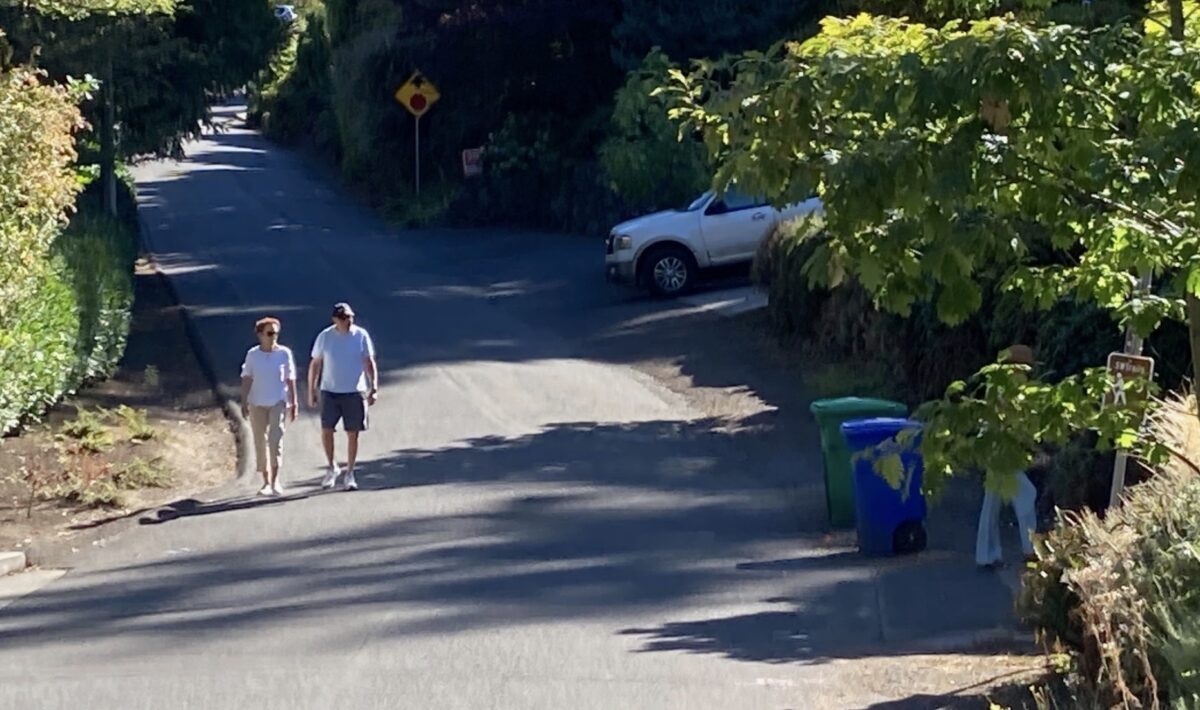
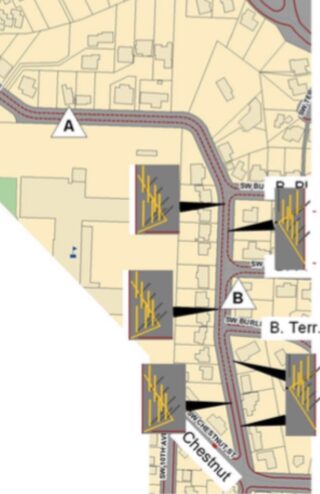
(Source: PBOT report on project submitted by neighborhood.)
For example, in the Hillsdale neighborhood, SW Burlingame Avenue neighbors have clamored for traffic calming for two decades. Although narrow, Burlingame runs along Ida B. Wells High School, and connects Beaverton-Hillsdale Hwy to Barbur Blvd. Drivers speed along it. The street was the subject of a PSU student’s Capstone project, and the student’s design (at right) was reviewed by a PBOT engineer. My understanding is that Burlingame Avenue is currently on a PBOT short list for traffic calming, although I don’t know if this would be the design. In the spirit of improving our city, I’m going to use this project as a paper tiger.
As you can see from the graphic, this design relies on a large burden of plastic wands. According to the reviewing engineer, each one of those wanded wedges requires a yield sign—in each direction! Additionally, each wedge should have an advance “road narrows” warning sign, although given “current low speed and volumes,” a “generic warning north and south of the test site” could be used. The price tag ends up being around $8,000.
That’s a lot of signs and plastic for a little street.
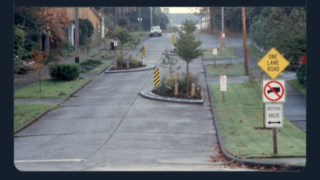
Instead (and in the spirit of thinking outside the box) I imagine the clever designers at PBOT drawing up five or so inexpensive treatments for various street scenarios. A treatment could be as simple as a basketball hoop on the side of the road, or as elaborate as the chicane created from planters in the road (at right). Neighborhoods could apply for a permit to calm their narrow street, and select a PBOT-approved design. The process could include having the approval of some percentage of the residents. Grants could be available for neighborhoods which need financial assistance with materials.
East Portland
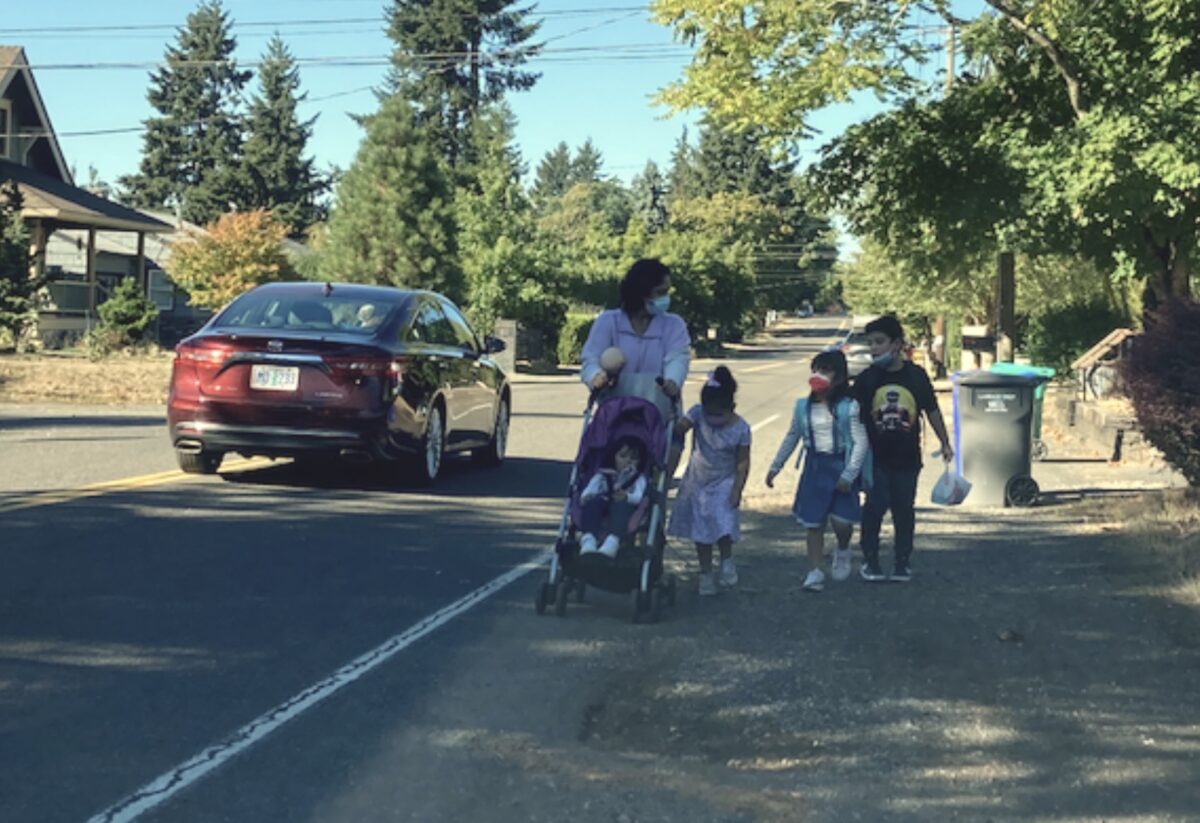
People have noted that southwest and east Portland face similar infrastructure inadequacies, and that is true. But I have yet to see a street in east Portland where I thought I might bump into a Hobbit, the way I often feel when I am in the Multnomah neighborhood. So a few weeks ago, I spent some time on 117th, between SE Market and Stark.
I didn’t measure the road, but it seemed narrow. I met Maria, who walks the roadway every weekday to pick up her two eldest children from the bus stop. She told me the road was awful to walk on and that “cars drive too fast and don’t slow down” for her. Unfortunately, that’s not surprising. Everything about this road tells the selfish driver that it belongs to them. As I stood on the shoulder a driver honked at me, maybe it was a warning honk, but it was loud enough to be a “why are you breathing my oxygen” honk. Nothing about the street says that Maria has a right to be there too. She deserves a promenade, or at least a row of trees, but that is a bigger project than a group of neighbors can support. We need creative, inexpensive designs to reassert the right of people walking and rolling to have a place in the right-of-way.
The statutory speed limit for a NRR is 15 mph, but Portland Ordinance 188774 directs PBOT to post non-arterial streets in residence districts at 5 MPH slower than their statutory speed, which would be 10 MPH. As we’ve urged before, they should do that.
When it comes to a relative easy way for us to address Vision Zero, give Portlanders a stronger connection to their neighborhoods, and create more people-centered streets — narrow residential roadways are Portland’s low-hanging, live-saving, fruit.



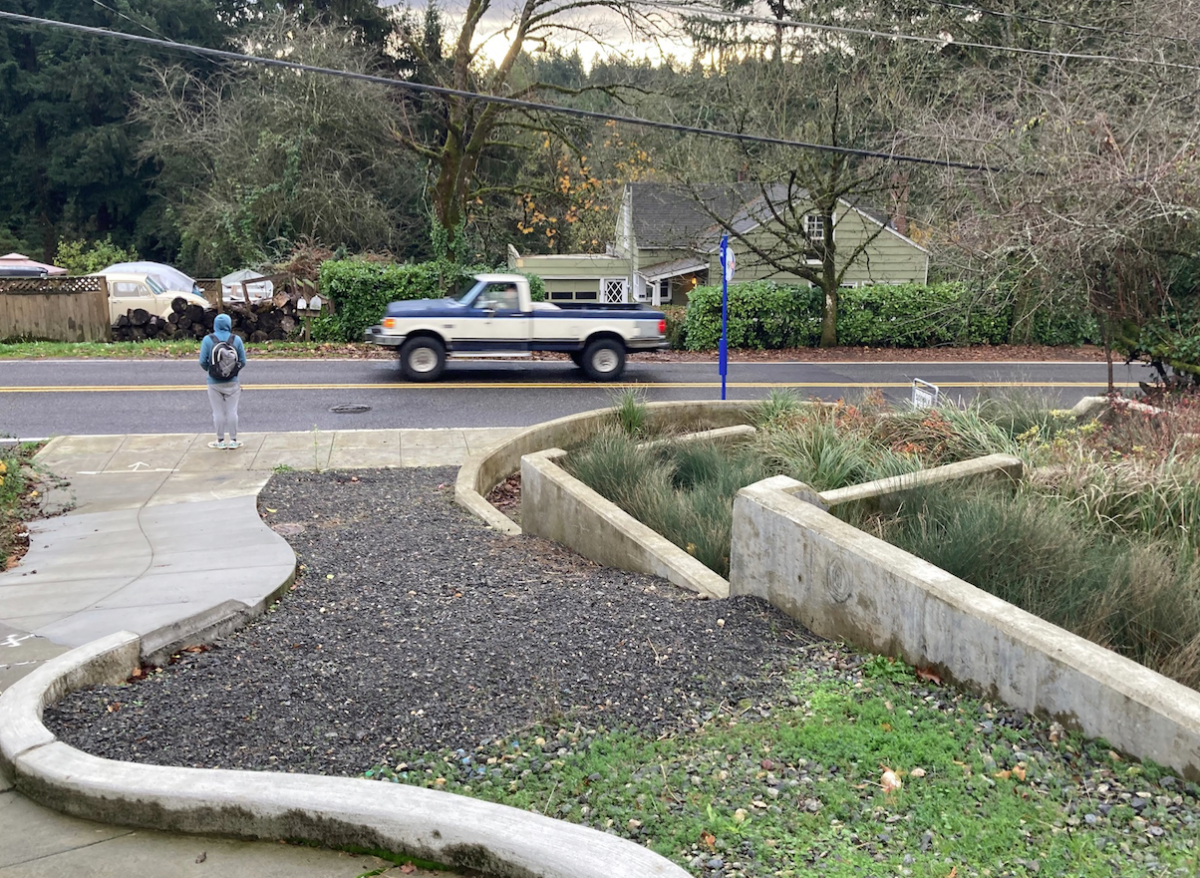
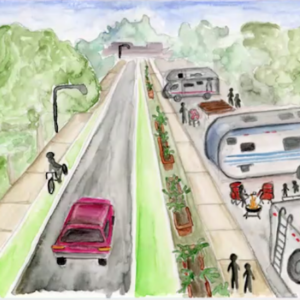



Thanks for reading.
BikePortland has served this community with independent community journalism since 2005. We rely on subscriptions from readers like you to survive. Your financial support is vital in keeping this valuable resource alive and well.
Please subscribe today to strengthen and expand our work.
Tuscaloosa AL has a bunch of narrow one-way chicanes between the downtown and the university that use parked cars to slow traffic: https://www.google.com/maps/@33.209627,-87.5590475,3a,75y,270h,90t/data=!3m7!1e1!3m5!1s7iZqJw056f9WnBSsx3LXhA!2e0!6shttps:%2F%2Fstreetviewpixels-pa.googleapis.com%2Fv1%2Fthumbnail%3Fpanoid%3D7iZqJw056f9WnBSsx3LXhA%26cb_client%3Dmaps_sv.tactile.gps%26w%3D203%26h%3D100%26yaw%3D75.71399%26pitch%3D0%26thumbfov%3D100!7i16384!8i8192
SE 117th from Burnside to Division is a collector street, not a local residential street (the NE portion on the other hand is local, full of gravel and potholes on some of it). PBOT traffic engineers were told by neighbors as recently as 1997 that they didn’t want sidewalks – and as you know, the engineers hold all the money at PBOT. SE 117th north of Stark is in the Hazelwood NA; south of Stark to Division it’s in the Mill Park NA. SE Harold in Powellhurst-Gilbert, SE Main in Centennial, and NE San Rafael in Parkrose Heights Russel are similar streets.
SE 136th used to be just like 117th, but after spending $18 million over 11 years, it’s now barely up to standard.
Ord 188774 applies to non-arterial streets in residence districts, that includes collectors. I just checked on google streetview, this section of SE 117th, just north of Market, is posted 20 mph.
Sorry, I keep editing this comment. If the travel lane is 18 ft or less, it is a NRR and should be posted 15 mph by state statute, 10 mph if you take Ord 188774 into account.
If it is close to 18 ft, but say a little over, PBOT could narrow the street to 18 ft with white paint, or a curb, and post it all the way down to 10 mph. 122nd is just a couple blocks away, so someone who wants to travel faster can take that street.
Local residents hate 122nd as it is a high-crash corridor and use parallel streets like 117th and 136th because they are perceived as safer for car drivers. But I agree, pass-through traffic should be using the main streets and not collectors – on the other hand, PBOT and the neighborhoods want road diets and traffic slowed on 122nd too.
When PBOT first started discussing this, SE Mill from 82nd to 89th in Montevilla was often used as a prime example: https://www.google.com/maps/@45.5100641,-122.5728438,3a,75y,270h,90t/data=!3m6!1e1!3m4!1s-ZhV5JIg04FOiR_W-xhDVQ!2e0!7i16384!8i8192
Or SE Clay in Hazelwood: https://www.google.com/maps/@45.5133279,-122.5545063,3a,75y,344.12h,90t/data=!3m7!1e1!3m5!1sX1gPxCg62LI0ORXH0Y1F8A!2e0!6shttps:%2F%2Fstreetviewpixels-pa.googleapis.com%2Fv1%2Fthumbnail%3Fpanoid%3DX1gPxCg62LI0ORXH0Y1F8A%26cb_client%3Dmaps_sv.tactile.gps%26w%3D203%26h%3D100%26yaw%3D348.7238%26pitch%3D0%26thumbfov%3D100!7i13312!8i6656
Yes to 10 mph! Yes to NRRs! Yes to inexpensive ways to slow drivers and, more importantly, foster people streets! Let’s stop pouring concrete everywhere (or, saying we can’t afford to do so), and instead use our ingenuity and resourcefulness to create a built environment people can enjoy in peace and community.
Thank you for writing this.
I’m a little confused. How does the role of sidewalks/no sidewalks play into this conversation? Is the suggestion that no sidewalks are better because the road is less improved, the road is likely narrower, pedestrians are more often on the road, and therefore traffic should be slower?
My concern is that unless traffic is slower, pedestrians should not be (or should be concerned about being) on the roadway. I don’t think pedestrians using the roadway should be relied upon to encourage drivers to go slower. Which comes first – slower traffic or more pedestrians? The old chicken and egg problem.
I know there was more to the article than this point, but I was interested in clarifying this detail.
Hi Walter,
Thank you for writing. It’s not really a chicken or egg problem.
Currently, today, tomorrow, and yesterday, people in SW and East Portland have to walk on the side of the road without a curb or cement sidewalk. It’s already that way, and it is a dangerous situation in many places.
I’ll quote a phrase that SWTrails uses: “SW PDX has 280 mi of streets, but 210 mi have no sidewalks.”
“No” as in none on either side.
It’s an issue with some history that I’ve written about, here’s a start: https://bikeportland.org/2021/08/12/sidewalks-and-portland-its-not-so-simple-336493
Personally, I believe if there is not a safe place to walk, or a convenient alternative route, the speed of the street should be lowered. Ord 188774 *requires* that the city lower the speed by 5 mph on all non-arterials in residence districts, that is what the successful “20 is plenty” campaign was about. But they aren’t fully implementing it on collectors in residence districts, and those are the most dangerous streets in SW.
Good luck!
One point to be kept in mind when doing any improvements in the ROW is, are they safe for all users? There has been no mention by PBOT (or many others) of how a person who is visually impaired, or blind, will be able to use these “Pedestrian Shared Streets”, like SW 19th. There is no place that’s even relatively safe for the visually impaired. Their guide to where the edge of the street is seems to be parked cars on one side, and the edge of asphalt on the other. They have no way of telling where an oncoming car is in the roadway. Of all the “Alternative Pedestrian Walkways” in the new Design Guide, only the Protected Safer Shoulder (with a raised strip to separate the modes), the “separated walkway”, or the “sidewalk on one side”, are usable by more than the able-bodied and sighted population. As far as lower speed limits, how fast are cars going on your street? Are they all staying at 20 MPH? If the answer is no, how fast will they go on a 15 mph street?
Thank you for responding Doug. All good points. Regarding speed limit setting, my understanding is that which type of traffic calming is allowed depends on the posted speed. I think the strategy is that, if you can lower the speed, you can permit some types of calming that otherwise might not be allowed, you can engineer for a slower speed.
Where I live, yes, it seems to me that most people are driving more slowly than they used to, and the PSU study showed that that 20 is plenty has had a positive effect. Do we get the occasional idiot? Sure, I just wish the city would replace the wrought iron railings (although hopefully the missing fences and dives down embankments serve as a warning).